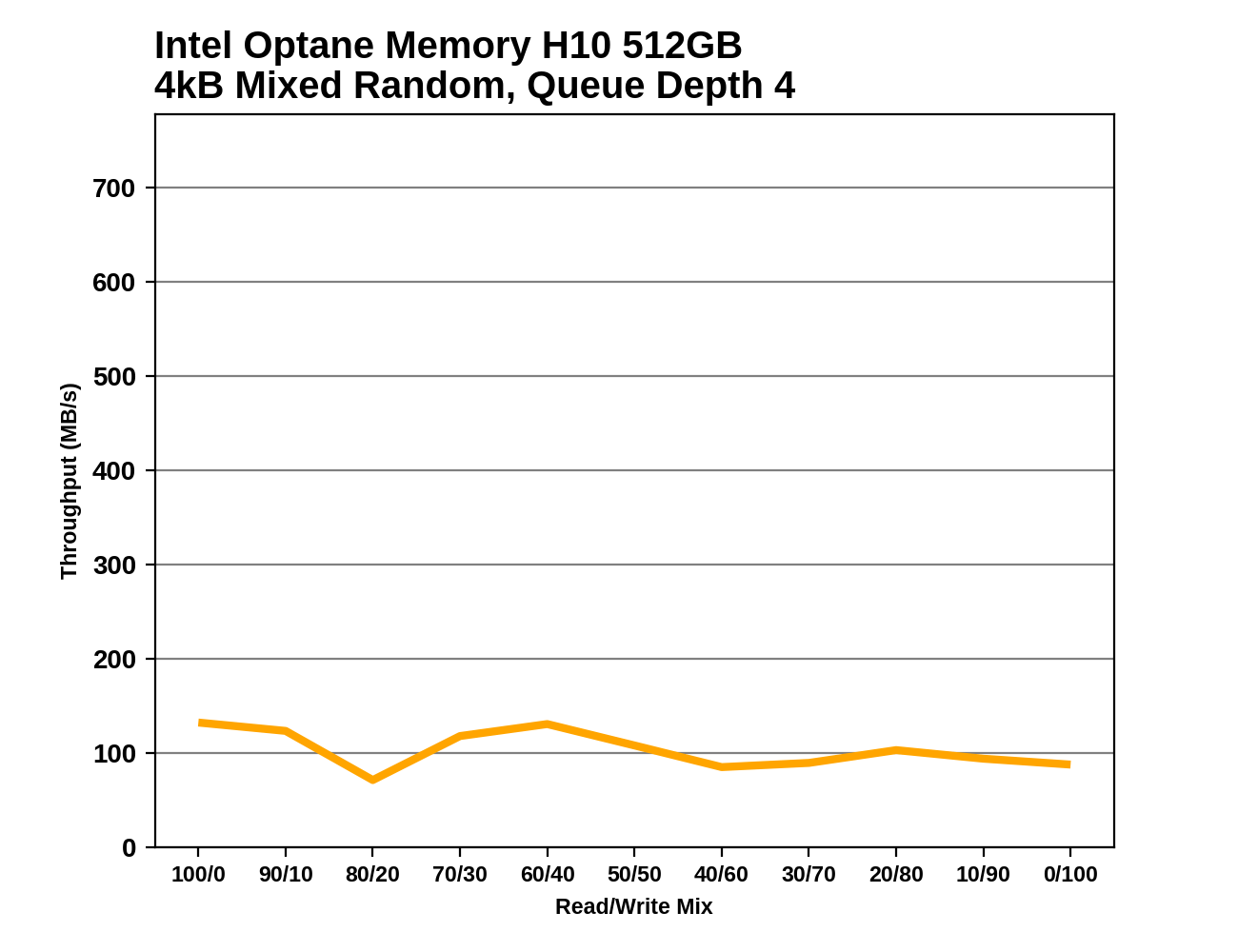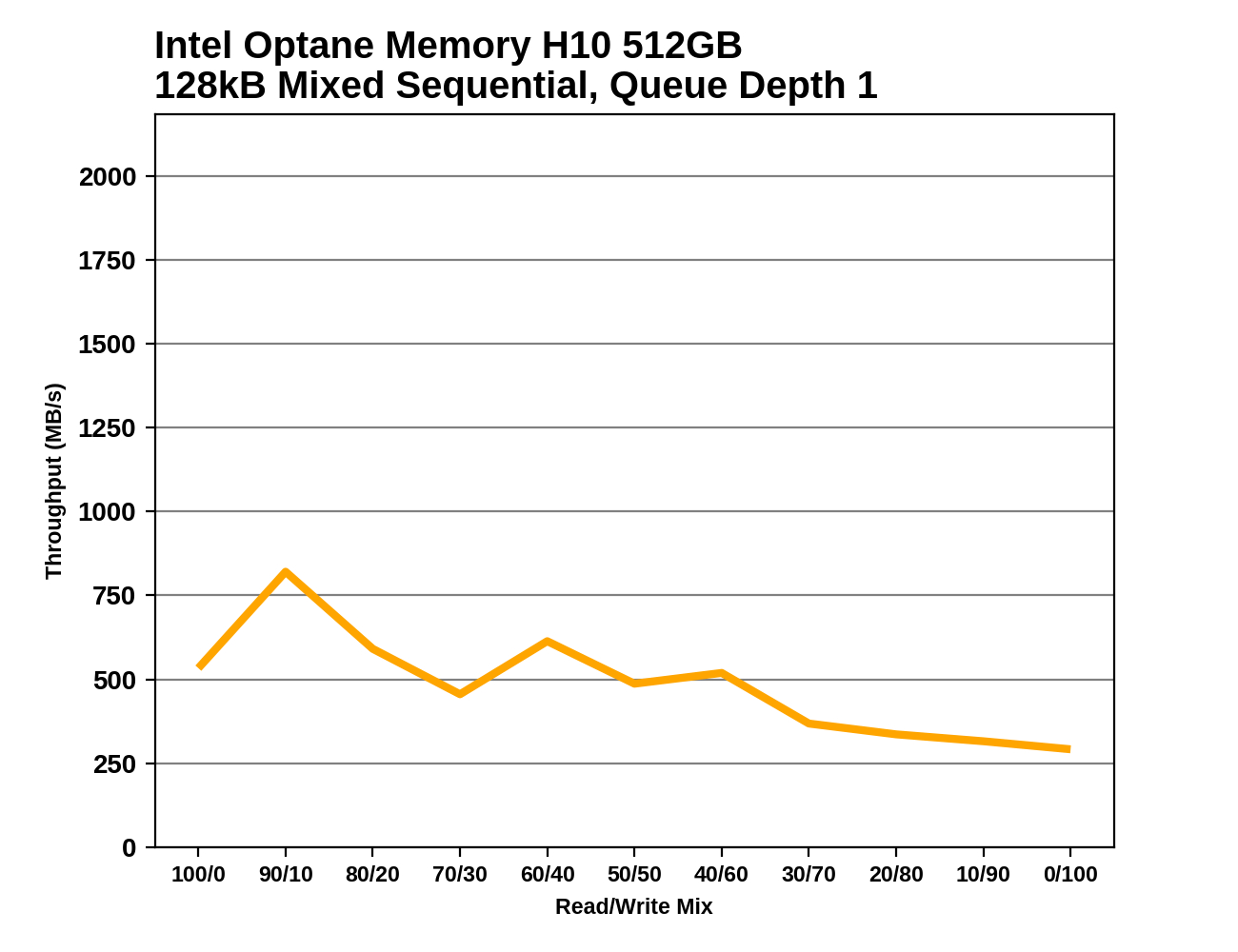The Intel Optane Memory H10 Review: QLC and Optane In One SSD
by Billy Tallis on April 22, 2019 11:50 AM ESTMixed Random Performance
Our test of mixed random reads and writes covers mixes varying from pure reads to pure writes at 10% increments. Each mix is tested for up to 1 minute or 32GB of data transferred. The test is conducted with a queue depth of 4, and is limited to a 64GB span of the drive. In between each mix, the drive is given idle time of up to one minute so that the overall duty cycle is 50%.

The performance of the Optane Memory H10 on the mixed random IO test is worse than either half of the drive provides on its own. The test covers a wider span than the 32GB Optane cache can handle, so the caching software's attempts to help end up being detrimental.
 |
|||||||||
The QLC portion of the H10 performs similarly to the Optane caching configuration during the read-heavy half of the test, though the caching makes performance less consistent. During the write heavy half of the test, the QLC-only configuration picks up significant speed over the Optane caching setup, until its SLC cache starts to run out at the very end.
Mixed Sequential Performance
Our test of mixed sequential reads and writes differs from the mixed random I/O test by performing 128kB sequential accesses rather than 4kB accesses at random locations, and the sequential test is conducted at queue depth 1. The range of mixes tested is the same, and the timing and limits on data transfers are also the same as above.

The Optane Memory H10 averages a bit better than SATA SSDs on the mixed sequential IO test, but there's a significant gap between the H10 and the high-end TLC-based drives. This is another scenario where the Optane caching software can't find a way to consistently help, and the H10's overall performance is a bit lower than it would have been relying on just the QLC NAND with its SLC cache.
 |
|||||||||
The caching software contributes to inconsistent performance for the Optane Memory H10 but the general trend is toward lower performance as the workload becomes more write heavy. The QLC portion on its own is able to increase speed during the second half of the test because it is quite effective at combining writes.










60 Comments
View All Comments
Alexvrb - Monday, April 22, 2019 - link
"The caching is managed entirely in software, and the host system accesses the Optane and QLC sides of the H10 independently. "So, it's already got serious baggage. But wait, there's more!
"In practice, the 660p almost never needed more bandwidth than an x2 link can provide, so this isn't a significant bottleneck."
Yeah OK, what about the Optane side of things?
Samus - Tuesday, April 23, 2019 - link
They totally nerf'd this thing with 2x PCIe.PeachNCream - Tuesday, April 23, 2019 - link
Linux handles Optane pretty easily without any Intel software through bcache. I'm not sure why Anandtech can't test that, but maybe just a lack of awareness.https://www.phoronix.com/scan.php?page=article&...
Billy Tallis - Tuesday, April 23, 2019 - link
Testing bcache performance won't tell us anything about how Intel's caching software behaves, only how bcache behaves. I'm not particularly interested in doing a review that would have such a narrow audience. And bcache is pretty thoroughly documented so it's easier to predict how it will handle different workloads without actually testing.easy_rider - Wednesday, April 24, 2019 - link
Is there a reliable review of 118gb intel optane ssd in M2 form factor? Does it make sense to hunt it down and put as a system drive in the dual-m2 laptop?name99 - Thursday, April 25, 2019 - link
"QLC NAND needs a performance boost to be competitive against mainstream TLC-based SSDs"The real question is what dimension, if any, does this thing win on?
OK, it may not be the fastest out there? But does it, say, provide approximately leading edge TLC speed at QLC prices, so it wins by being cheap?
Because just having a cache is meaningless. Any QLC drive that isn't complete garbage will have a controller-managed cache created by using the QLC flash as SLC; and the better controllers will slowly degrade across the entire drive, maintaining always an SLC cache, but also using the entire drive (till its filled up) as SLC, then switching blocks to MLC, then to TLC, and only when the drive is approaching capacity, using blocks as QLC.
So the question is not "does it give cached performance to a QLC drive", the question is does it give better performance or better price than other QLC solutions?
albert89 - Saturday, April 27, 2019 - link
Didn't I tell ya ? Optane's capacity was too small for many yrs and compatible with a very tiny number devices/hardware/OS. She played the game of hard to get and now no guy wants her.peevee - Monday, April 29, 2019 - link
"The caching is managed entirely in software, and the host system accesses the Optane and QLC sides of the H10 independently. Each half of the drive has two PCIe lanes dedicated to it."Fail.
ironargonaut - Monday, April 29, 2019 - link
"While the Optane Memory H10 got us into our Word document in about 5 seconds, the TLC-based 760P took 29 seconds to open the file. In fact, we waited so long that near the end of the run, we went ahead and also launched Google Chrome with it preset to open four websites. "https://www.pcworld.com/article/3389742/intel-opta...
Win
realgundam - Saturday, November 16, 2019 - link
What if you have a normal 660p and an Optane stick? would it do the same thing?